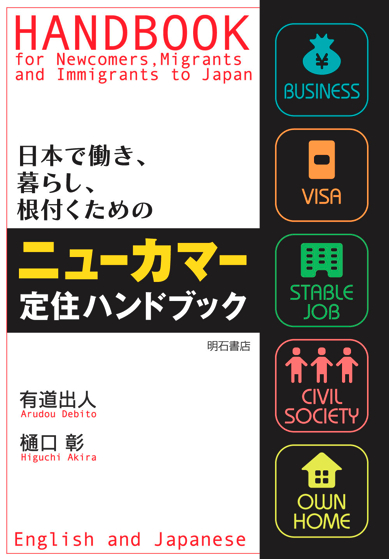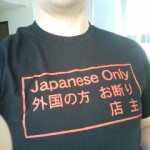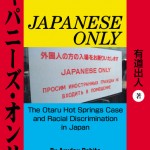mytest






![]()

UPDATES ON TWITTER: arudoudebito
DEBITO.ORG PODCASTS on iTunes, subscribe free
Hi Blog. Get a load of this:
///////////////////////////////////////////////////
The Japan Times Saturday, May 14, 2011
Foreigners key to recovery: Iokibe
http://search.japantimes.co.jp/cgi-bin/nn20110514a8.html
Kyodo — Large numbers of foreigners will be needed to help revive the farming and fishery industries in areas damaged by the March 11 mega-quake and tsunami, the head of a reconstruction panel said Friday.
“It is important to draw human resources, including permanent foreign residents” to the hard-hit Tohoku region, Makoto Iokibe, chair of the Reconstruction Design Council, said at the Japan National Press Club.
Iokibe said many cities and towns in the region, known for its strong farming and fishery industries, were suffering from depopulation evern before the calamities, so population growth will be vital to rebuilding the area.
Iokibe, who is also president of the National Defense Academy of Japan, said the country cannot avoid a debate on raising taxes to fund reconstruction, given its heavy debt load and fiscal constraints.
The advisory panel to Prime Minister Naoto Kan, which Iokibe took charge of in early April, has been asked to develop the first set of reconstruction proposals by the end of June.
ENDS
///////////////////////////////////////////////////
COMMENT: As submitter CJ commented: “What foreigner WOULDN’T leap at the opportunity to perform manual labor all day bathed in background radiation while being treated like a potential criminal and expected to leave when no longer needed, sacrificing pension contributions in the course of doing so?”
Touche. Especially since day laborers are now a hot commodity for hot radioactive reactor cleanups, see below. Get freshly-imported foreign workers doing this instead and you’ll have no family in Japan complaining. Arudou Debito
///////////////////////////////////////////////////
Osaka day laborer duped into reactor cleanup
OSAKA — An Osaka day laborer who responded to an ad for a truck driver in Miyagi Prefecture found himself working beside the Fukushima No. 1 nuclear power station, it was learned Monday.
The man, whose name has not been released, has filed a complaint with a job placement center in Osaka’s Airin day labor district. The Osaka district labor bureau is also investigating the case.
According to the Airin center, a job notice came around March 17 from a Gifu-based firm, Hokuriku Koki, which was seeking a truck driver in Onagawa, Miyagi Prefecture. Onagawa is also home to a nuclear power station, but Yoji Takeshita, an Airin job center official, said the ad did not specify where the driver was supposed to take the truck.
The job promised ¥12,000 a day and the contract was for one month.
But about a week later, the man called the Airin center saying he was actually in Fukushima, not Miyagi Prefecture, and that he was wearing protective clothing and cleaning up debris around the Fukushima No. 1 power plant.
On Monday, after the center spoke to the man and Hokuriku Koki, it was further learned he had spent about two weeks near reactors No. 5 and No. 6, working with water tankers to supply the pumps that were being used to keep them cool…
The man completed his work and returned to Osaka in late April. But he filed a complaint with the Airin center, saying that while he was paid ¥24,000 a day — twice what he’d been promised — he didn’t receive a radiation badge until the fourth day on the job and that the work was different from what he had been promised…
Full article at
http://search.japantimes.co.jp/cgi-bin/nn20110510a3.html
ENDS
16 comments on “JT/Kyodo: NJ key to Japan’s recovery, says Iokibe Makoto, chair of GOJ Reconstruction Design Council. Well, fancy that.”
Anyone setting foot within the exclusion zone of the reactors should be wearing a chest badge at all times, and have a throat check for the thyroid. In Tokyo, the background radiation has been twice as high as normal, but the actual numbers are negligible as far as allowable doses are concerned. However, the iodine isotopes have a half-life of 8 days, but accumulate within the thyroid. The cesium isotopes have much longer half-lives. I worked with P32 every day for four years in grad school, and my badge barely ever showed a blip on the readouts. In order to keep my dosages that low, I had three sources of shielding at all times. These workers have no shielding, and protective clothing doesn’t keep those excess neutrons from blasting through the body.
Why are they so interested in rebuilding? If the populations of the area were declining anyway, then why bring in a bunch of “criminal” foreigners to clean up an area that was in decline? I would say that the best thing an activist could do would be to get in contact with any day laborers they are attempting to contact and give them the full story. Very few people understand radiation and how it works, it’s easy to dupe them into thinking it’s not that bad.
Nowhere in the first article does it say anything about Fukushima. Areas damaged by the quake include even Chiba, and considering the extent of the damage, once the JSDF leaves the area, it’s going to take a lot of manpower to get the areas up and running. It took Kobe 10 years to get back to a reasonable level of completeness, so one can only imagine how long it’s going to take this time.
Again, Fukushima was not the only area damaged by the earthquakes, and for the most part, the areas that require actual rebuilding have not been exposed to radiation.
Indeed Dr H, as you say, “very few people understand radiation and how it works”; and (s)he appears to be one of them. I’m no nuclear physicist, but I am a registered radiation user in Japan, so maybe I might be allowed to expose the fallacies you seem keen to perpetuate.
Due to iodine-131’s relatively short half-life the level of radioactive iodine in the region of the power plant will now be only slightly raised from background level, as this isotope is only produced during the high-energy decay in a fully active reactor. So there is no risk of thyroid accumulation any more. Other isotopes will of course be present and do present a danger especially if inhaled or ingested. Of course, this will be prevented by the protective barrier clothing. All workers are supposed to wear passive dosimeters (like your chest badges), which monitor their absorbed does and there is no evidence that doses below 100mSv induce any harmful effects (including long term cancers). Most importantly workers at the plant, and to date rescue crews in the zone, have had active monitors (sometimes these have been shared over a group – which is a little naughty), these alarms will warn if workers come on areas where radiation is at active levels. I very much doubt that Japanese radiation rules will be relaxed over the next few years for foreign workers in the evacuation zone and indeed as evidence increases the zones themselves will be increased/relaxed in line with actual data of long-term doses.
Regarding your experience, as I’m sure you know, P32 is a beta emitter (a high energy one though), but such radiation will be stopped by short air gaps, thus chest badges (although generally required) have little value in measuring your exposure; your hands that worked close to the sources will have received much larger (but of course still safe) doses. Fortunately, the normal SOP for P32 work is to wear a double glove layer and this will provide a useful shielding and a good level of protection. Full protective suits and respiratory protection work in a similar way to provide a good protection (just like staying indoors), but I think it’s reasonable to assume that the areas untrained clean-up workers would operate in would be checked and would only be low level radioactive anyway.
Not sure where you think these “excess neutrons” will be coming from in the exclusion zone, as the strontium and caesium isotopes that are responsible for most of the contamination outside the reactor are beta emitters with some gamma rays.
This is a good story about integrating NJ into the rebuilding process of affected areas (not just radioactive ones); why not praise it?
Icarus
Still, no one from the countries Japan deems ‘desirable’ is going to want to live here in the future.
There are plenty of people just waiting to immigrate. Too bad they are not of the origin that Japan wants.
We are doing a favor to Japan by being here. It is not the other way around.
Forgive the “scare mongering” however just 2 months ago I remember Debito-san and I being lambasted and called numerous names, here and elsewhere for stating what showed up in yesterday’s Asahi Shimbum.
I agree with Icarus – the scope of the task ahead is beyond one’s imagination.
— And I suppose capitulation by the nonconstructive critics is beyond their imagination too. Typical.
/////////////////////////////////////
Meltdowns also likely occurred at No. 2, No. 3 reactors of Fukushima plant
Asahi Shimbun 2011/05/18
http://www.asahi.com/english/TKY201105170428.html
Data shows meltdowns occurred at the No. 2 and No. 3 reactors of the Fukushima No. 1 nuclear power plant, creating huge problems for the plant operator that had presented a more optimistic scenario.
And like the No. 1 reactor, the melted fuel appears to have created holes in the pressure vessel of the No. 3 reactor, according to the data of Tokyo Electric Power Co. released May 16.
Goshi Hosono, special adviser to Prime Minister Naoto Kan, acknowledged the likelihood of meltdowns at the No. 2 and No. 3 reactors.
“We have to assume that meltdowns have taken place,” Hosono said at a news conference May 16.
Haruki Madarame, chairman of the Nuclear Safety Commission, said in a separate news conference the same day that the meltdowns should not come as a surprise.
“When highly contaminated water was found at the No. 2 reactor building in late March, we recognized that a meltdown had taken place. So I informed the government,” he said. “As for No. 1 and No. 3 reactors, we recognized that, given the processes that led to the accidents there, the same thing had occurred.”
Immediately after the crisis erupted at the nuclear power plant in March, experts pointed out that meltdowns likely occurred at all three reactors.
But TEPCO’s measures to contain the crisis have been based on the assumption of lighter damage to the reactor cores.
TEPCO had said it believed that only a portion of the nuclear fuel rods had melted. Now, it appears that all parts of the fuel rods have melted.
TEPCO recently said a meltdown likely occurred at the No. 1 reactor. But a TEPCO official on May 16 declined to comment on the possibility of meltdowns at the No. 2 and No. 3 reactors.
“We have yet to be able to grasp the entire situation at the plant,” the official said.
A meltdown is a situation in which nuclear fuel melts and accumulates at the bottom of the reactor pressure vessel, which is located inside a containment vessel.
At the No. 3 reactor, the melted fuel may have burned through the pressure vessel to the containment vessel, the data showed.
TEPCO on April 17 released a schedule to reach a cold shutdown at the Fukushima plant within six to nine months.
However, given the latest data, the embattled company will have to drastically modify its plans.
If meltdowns have indeed occurred, more time will be needed to construct a system that cools the reactors. In addition, the company will be tasked with the huge chore of disposing of massive amounts of highly contaminated water.
TEPCO’s latest data describes the situation immediately after the Great East Japan Earthquake and tsunami devastated the coast of the Tohoku region on March 11.
Release of the data, which had been kept at the central control room at the nuclear power plant, was delayed because it took time to restore power and remove radioactive materials attached to the papers.
According to the data, the pressure in the pressure vessel of the No. 2 reactor dropped at 6:43 p.m. on March 15. A similar drop in pressure also took place at the No. 3 reactor at 11:50 p.m. on March 16.
Those declines were apparently the result of holes made in the pressure vessels.
Previously, it was believed that water was leaking through holes at the bottom of the pressure vessels where measuring instruments and part of the control rod mechanisms were located.
Now, it appears that melted nuclear fuel formed new holes in the pressure vessels.
Radioactive materials, such as technetium, produced when nuclear fuel rods are damaged, have been detected in water in the No. 3 reactor building. That discovery has raised speculation that the melted nuclear fuel has breached the pressure vessel and landed in the containment vessel.
During the meltdown at Three Mile Island in the United States in 1979, the fuel remained in the pressure vessel. But work to remove the melted fuel from the pressure vessel, which started in 1985, took five years to complete. An additional three years were needed to confirm that radioactive contamination had been removed from the reactor.
Given the more serious situation at the Fukushima plant, some nuclear experts say more than 10 years will be needed to remove the melted fuel, eliminate the contamination and dismantle the reactors.
Fumiya Tanabe, a former senior researcher at what was then the government-affiliated Japan Atomic Energy Research Institute, said black smoke from the No. 3 reactor building in the days after the earthquake and available data on pressure showed early on that a meltdown had taken place.
“Before we saw TEPCO’s data (released on May 16), we had been already aware of the possibility (of a meltdown),” he said.
Tanabe criticized TEPCO’s recovery efforts and measures that were taken based on a situation that was much less serious than reality.
He said TEPCO’s optimistic scenario led three workers to be exposed to highly radioactive water on March 24 and prevented measures to keep contaminated water from leaking into the sea through a trench at the No. 2 reactor building.
“In resolving serious accidents like those (at the Fukushima plant), it is a cardinal rule to work out recovery measures based on the worst possible situation,” he said.
ENDS
Unknown, which countries does Japan consider desirable? Please include a link to this information.
—————–
I’m sure there are a lot of people that can see the potential in integrating with a city’s populace during a rebuilding. By being part of the recovery/rebuilding efforts, you are essentially staking out a permanent part of that area. The locals will see and applaud your efforts, and be much more inclined to support your business in the future.
Much like the Pakistani man who opened his ryokan to elderly evacuees, there is a lot of help that can be provided by hard working foreigners with a look to the future. This is the same as in Japan as it is in any place around the world experiencing a disaster.
— Hope so. Let’s hope the gratitude is enough to counteract all the media-created “Fly-jin” propaganda.
@Nogbad…so there is no more release of iodine? I spoke with a prominent nuclear physicist on a Science mag webchat, and he seemed to indicate that even though the half life is very short, that there is still more being released. Don’t get me wrong, he was very adamant that the isotopes getting out into the water were not that big a deal. If I am wrong, then that makes me glad. But I still think that even with protective clothing that if you are contaminated, removing the clothing gets the source of radiation off of the body, but for the time it is close to the body it is still capable of causing DNA damage. Not a problem if it’s in the surface skin cells, but if it penetrates deeper into the body it can cause significant damage. The odds are very very slim, that DNA damage would happen to be in an oncogene, but it’s still possible. Please correct me if I’m wrong. (And yes, it is very very naughty to share a detector among a group of people.)
Furthermore, the cesium isotopes are being found in the soil right? That’s why there was the whole hysteria about eating vegetables. What’s the half-life? Several years, yes? I just wonder if the media and TEPCO can be trusted to reveal all the information available, or try to minimize hysteria. Because the average lay person doesn’t even understand what radiation is.
BTW, I used a ring badge. 🙂 I should have made that clear in my comment, my bad. The most I ever used at one time was 5 millicuries. For beta-emitters, low-density shielding is best, but for the gamma-emitters (such as at the plant) require high-density shielding, correct? The protective clothing is not made of high-density concrete. How does it protect?
Furthermore…cesium and strontium beta-emitters are such because of excess neutrons, correct? If not, then I need to have a talk with my safety officer on his teaching. 😉
— We’re getting way off track here. One more post from each of you on this please, then that’s it for this thread, thanks.
Gomen nasai Debito. 🙂
Thanks, Debito.
I didn’t mean to derail this thread into a discussion about radiation, but I was just concerned at the inflammatory tone of Dr H and how that might unduly worry your readers who are not so comfortable with the dangers of radioactivity as Dr H and I.
Not wanting to expand this too much further, but I’ll deal with a couple of points.
Yes, absolutely anyone in the zone will have more DNA damage, however at those slight chances are indistinguishable from the slight chances of oncogene mutation caused by background radiation at additional doses below 100mSv, thus no increases in cancer. Interestingly, there is evidence that increase exposure above background slightly in fact actually reduces cancer rates, perhaps due to increased DNA repair – however, this is difficult to study as there is a bit of an ethical problem in doing the experiments needed. Also how cumulative exposure works isn’t really understood; generally safely limits are based on annual limits, and hopefully Tepco are doing as they say and removing workers for the rest of the year once their badges indicate they have exceeded 100mSV, active monitors help them estimate the time they should work in an areas, but even with this, a few workers have exceeded 150mSV – that is not good.
Regarding the iodine, as I say I’m no nuclear physicist, but as I understood it, sub-critical uranium or plutonium decay does not yield iodine isotopes; iodine isotopes will still be released as there was probably massive amounts of them produced in the reactors before cooling took place and I daresay that until cold shutdown small amounts of iodine may still be produced. The important data here is that the radioactivity of iodine in the air and being released into the sea at the intakes is at tiny levels now due to the half-life. Thyroid accumulation of iodine-131 isn’t a big worry now – but the caesium is – much longer half-life and so decay won’t deplete it, it’s going to have to be removed from the hot zone to a level where people can be safely moved back in. Every one living in Europe still has increased radiation exposure every year due to the caesium released by from Chernobyl and it is going to be around for many years to come -I guess similar lines will have to be drawn around Fukushima and even after the clean up, there will probably be areas that won’t be safe for daily living for some time to come.
There will be a lot of gamma as well as beta radiation from the released particles, but the point of the suits isn’t to block this – it won’t. Preventing skin and respiratory tract contact is key, as is making decontamination easy. The idea with gamma is make sure of the levels in the work area are safe for the time they plan to work there and monitor doses they were exposed to with individual dosimeters. Gamma shielding requires walls being built out of lead sheets or special bricks.
Yes, there are excess neutrons, and this is indeed what makes them radioisotopes, but they don’t emit them in the decay that workers would encounter – come on, accept that saying “those excess neutrons from blasting through the body” isn’t really true and is over-dramatic.
I don’t doubt Dr H’s expertise, but these are complicated issues and it’s tricky to discuss this over a forum. I don’t want to quibble over little facts, so sorry for the tedious detail, but I think that precisely because not many people understand radiation enough to make reasoned judgements, we need to be careful about fanning the flames of fear. Indeed, look at the reveals this week – that at least one and probably three, reactors suffer complete meltdown, not just the partial melting discussed at the time, and rupture of the reactor and containment vessel. This is bad, but is makes no real difference now to people, except the the clean-up/decommissioning process. However, can you imagine what would have happened if ‘ “M” word confirmed on the day after the ‘quake? Not saying Tepco/Government knew for sure, but the idea was mentioned as a worse case possibility; even if they knew, would it have done any good to the average person to hear all those “scary” words that they don’t really understand fully?
Anyway, back on topic: I really think that this suggestion makes some sense. Other than CJ’s interpretation of the “truth” behind this proposal, I don’t see anything to suggest this has anything to do with radioactive clear-up. I know many NJ who would love to live in rural settings and work the land or sea, most of them have no chance of this life back home. I don’t know any young Japanese who want to lead this life. On the other hand, not sure about the suggestion that permanent residents would want to make this move. Maybe this is an opportunity for NJ to be at the heart of newly-formed rural communities and so the reconstruction design council should be watched to see how they intend to put their ideas into practice – anyone want to call them up?
If I’m overstepping the bounds here Debito, just delete my comment.
Neutron activation is common around reactors in meltdown scenarios, correct? Then my comment is not unwarranted. I wasn’t being intentionally inflammatory to scare anyone, but it should be made clear that people who are being sent into the exclusion zone without the appropriate apprisal (as the example of the day laborer) are in danger. Notice, I said “exclusion zone”. Not the entire country, not Hokkaido, not Tokyo. Just the exclusion zone, particularly near the reactor. It is not a safe happy-go-lucky place, so no, I won’t admit anything. People are quick to jump to conclusions and not get the whole picture…and sarcasm and tone are lost in this medium, so my apologies. My main concern here is the basic human rights of workers, not the concerns of media or TEPCO.
You’re probably right about NJ who would like to live in rural settings…I do know a few young Japanese who would love that life as well. Overall though, it’s probably not enough to foresee a future of twenty-something Japanese repopulating that area. But the fact remains that it sounds extremely arrogant to me for Iokibe and others to indicate that “gaijin” are needed, but they won’t be offered fast-track citizenship or some other compensation for going there. I’m on board with the comment that Debito included in the blog.
but here is an article written by a lifer NJ which although quite good in places has the opposite, rather depressing, conclusion (though he seems to be a J apologist in favor of it):
http://www.foreignpolicy.com/articles/2011/03/24/the_island_nation?page=0,1
“The quiet strength of today’s Japan is that the janitor in your apartment building is not a representative of “the other.” He is you. In fact, there are thousands of janitors in apartment buildings across Japan who cut the same rumpled figure as Kan in his blue overalls. It is this Japanese narrative of a shared suffering and renewal against all odds that will drive Japan’s post-quake development. We may wish the Japanese to become more like us, but that isn’t going to happen. As they set about the task of recovery, they will become more like themselves.”
Really? He is “You”. (Well, not you exactly, as You reading is probably an NJ). The one thing this writer seems to have forgotten is that when that ageing janitor retires, who is going to replace him? Sooner or later, the labor shortage is going to mean “you” just won’t get a janitor in the building if “you” and Hello Work keep saying “gaijin wa fuka”.
Have to disagree with the J apologist article Richard has posted. Japan has been in a deflationary cycle for the past 5 years or more, so the post bubble recovery is somewhat of a distortion of reality. He seems hint at praising Japans insular character, at believes this has been Japans savior throughout its history. In these global times, Im convinced that Japans insularism and introverted habits are what’s holding it back. You can only blame politics and regimes so much; after all, how many prime minister have we seen change over the last 10 years? To keep doing the same thing over and over when it doesn’t work is the definition of insanity. Many Japanese feel that the bubble will return, and work/think like it. They still expect a bonus 3 times a year and all the other trappings of the 80s and 90s. Salaries are still very high in Japan compared to Asia, but China is now #2 and growing like mad because they have embraced change. I think Japan is at a crossroad like it has never experienced before but is still electing old school hunker down politicians like Ishihara to keep us all “safe” from those evil outside influences like immigration. I think the author has missed the mark entirely with this article. He is correct when he says there are many misunderstandings about Japan, but unfortunately he also seems to be observing from a distance. You don’t need a PhD in Asian studies to understand Japan, you need to live here and experience it.
Rodney:
If you don’t recognize the author of the article…well, that tells everyone all they need to know. He knows more about Japan than all of us combined, and he is the polar opposite of a Japan apologist. He is a realist, however.
Go back and read the article. Pay close attention to what is says (and what it doesn’t say).
He is a realist? Seems more to be a defender of keeping the status quo- that is keeping out the immigrants to be, after all its benefical to Japan according to him.
“He knows more about Japan than all of us combined”
Tells me all I need to know about you.
“Inequality would probably rise; the wages of low-earning native workers would likely be deflated by the new competition, while the upper-middle class would benefit from the services of inexpensive cleaners, handymen, and baby sitters. The Japanese also fear a dilution of shimaguni konjo, the “island nation spirit” that has helped them cope with a series of disasters of apocalyptic proportions.”
So you agree with that? Sounds like something he overheard while having at a dinner with guest speaker Ishihara to me. Sorry, cant buy that one.
Interesting. Let’s look at the full quote, shall we?
**Japanese opinion tends to focus on the potential downsides of large-scale immigration: ** Inequality would probably rise; the wages of low-earning native workers would likely be deflated by the new competition, while the upper-middle class would benefit from the services of inexpensive cleaners, handymen, and baby sitters. The Japanese also fear a dilution of shimaguni konjo, the “island nation spirit” that has helped them cope with a series of disasters of apocalyptic proportions”.
Please tell us where he says that * believes this is what would happen. Please tell us where he ‘defends’ this or says this would be a good thing.
You don’t recognize the name of an extremely well-known and very highly respected Japan observers. You seem to think that the author is ‘observing from a distance’. You left out text of your quote that renders your entire point irrelevant, which was either done on purpose (intellectually dishonest) or by accident (incredibly poor reading comprehension).
Either way – tells everyone all we need to know about the weight we should lend your arguments.
— Let’s now bring the ad hominem to a close.